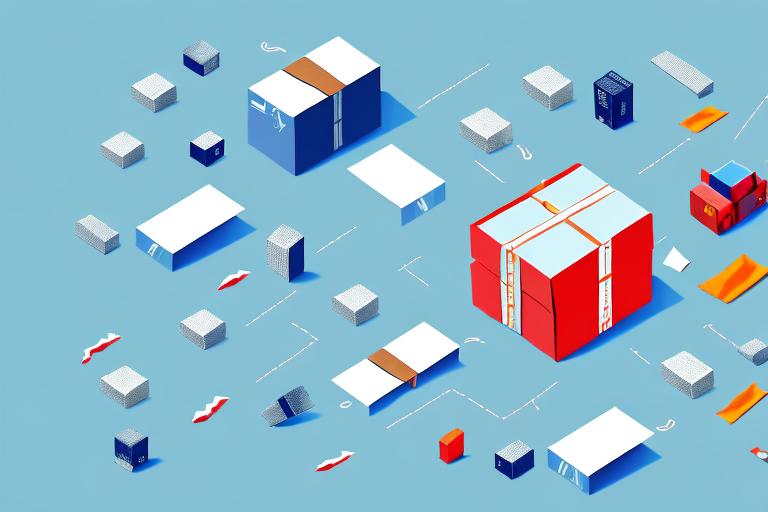How Inventory Linking Can Improve Your Supply Chain
If you are managing a business in the supply chain industry, you know that maintaining proper inventory levels is critical to ensuring smooth operations and timely delivery of goods. One effective strategy to achieve this is through inventory linking. In this article, we will explore what inventory linking is, its importance, how it works, and how to implement it in your business operations. We will also examine best practices for effective inventory linking, the role of technology in facilitating this process, and real-world examples of successful companies that have implemented inventory linking to streamline their supply chain.
Understanding Inventory Linking and Its Importance in the Supply Chain
Inventory linking is the process of connecting inventory information across the supply chain network. This means that every organization in the chain can access real-time information about inventory levels, order status, and delivery schedules. The main goal of inventory linking is to provide greater visibility into inventory levels, improve efficiency, and reduce costs.
Having access to real-time information about inventory levels is crucial for timely and accurate decision-making. According to a 2023 Supply Chain Management Report, businesses that utilize inventory linking strategies experience a 20% reduction in stockouts and a 15% decrease in overstock situations. Without this information, organizations may run into stockouts or overstock, leading to delays in delivery, unhappy customers, and ultimately lost revenue. Therefore, it is essential to have an inventory linking strategy in place to ensure that every organization in the supply chain has access to this information.
One of the key benefits of inventory linking is that it allows for better collaboration and communication between organizations in the supply chain. By sharing inventory information, organizations can work together to optimize inventory levels, reduce lead times, and improve overall supply chain performance. This can lead to cost savings for all parties involved, as well as improved customer satisfaction due to faster and more reliable delivery times.
For more insights on the impact of inventory linking, refer to the Industry Reports section of ShipScience.
The Benefits of Implementing Inventory Linking in Your Business
Implementing an effective inventory linking strategy can bring several benefits to your business, including:
- Improving visibility into inventory levels and order status
- Reducing stockouts and overstocks
- Streamlining business operations
- Reducing costs and increasing efficiency
- Enabling timely and accurate decision-making
By linking inventory information across the supply chain, businesses can optimize inventory levels, reduce waste, and minimize stockouts and overstocks. This ultimately leads to cost savings and higher customer satisfaction levels.
Another benefit of implementing inventory linking in your business is that it can help you identify trends and patterns in customer demand. By analyzing inventory data, you can gain insights into which products are selling well and which ones are not. This information can be used to make informed decisions about purchasing and stocking products, as well as developing marketing strategies to promote popular items. Additionally, inventory linking can help you identify potential supply chain disruptions and take proactive measures to mitigate their impact on your business.
A study by ShipScience Tech Innovations found that companies using inventory linking saw a 25% improvement in demand forecasting accuracy, leading to better inventory management and reduced holding costs.
Streamlining Your Supply Chain with Inventory Linking
Inventory linking streamlines the supply chain by connecting all organizations involved in the process. This means that information flows seamlessly, allowing each organization to know what is happening in real-time and adapt accordingly. As a result, decision-making is more efficient, and there is less room for errors or miscommunication among the organizations involved.
Streamlining your supply chain through inventory linking can also help to reduce lead times. By having access to real-time inventory levels, businesses can order products as soon as they are needed, reducing the time it takes to procure goods and deliver them to customers. Additionally, businesses can use this information to optimize their inventory levels, reducing the amount of time and money spent on storage and handling.
Another benefit of inventory linking is improved forecasting accuracy. By having access to real-time inventory data, businesses can better predict demand and adjust their production schedules accordingly. This can help to reduce waste and ensure that products are available when customers need them. Additionally, inventory linking can help to identify potential supply chain disruptions before they occur, allowing businesses to take proactive measures to mitigate the impact on their operations.
For detailed strategies on streamlining supply chains, visit the ShipScience Resources page.
How to Implement Inventory Linking in Your Business Operations
Implementing inventory linking in your business operations involves several steps, including:
- Identifying the organizations involved in your supply chain and their inventory systems
- Implementing a software solution that can integrate these systems and provide real-time inventory information across the supply chain
- Educating all stakeholders in the supply chain on the importance of inventory linking and how to use the software solution effectively
The most critical factor in implementing an effective inventory linking strategy is choosing the right software solution. The solution you choose should be flexible, scalable, and able to integrate with all inventory systems across the supply chain. It should also provide real-time information on inventory levels, order status, and delivery schedules, enabling timely and accurate decision-making.
Another important consideration when implementing inventory linking is ensuring data security and privacy. The software solution you choose should have robust security features to protect sensitive inventory information from unauthorized access or cyber threats. It is also essential to establish clear data sharing agreements and protocols with all organizations involved in the supply chain to ensure compliance with data protection regulations.
Learn more about selecting the right software in our Software Selection Guide.
Best Practices for Effective Inventory Linking in Your Supply Chain
Here are some best practices for effective inventory linking:
- Choose a software solution that can integrate with all inventory systems in the supply chain
- Educate all stakeholders in the supply chain on the importance of inventory linking and how to use the software solution effectively
- Regularly review and update your inventory linking strategy to ensure that it is meeting your business needs
- Ensure that all information flowing through the supply chain is accurate and up-to-date
Effective inventory linking is crucial for businesses to maintain a competitive edge in the market. It not only helps in reducing costs but also improves customer satisfaction by ensuring timely delivery of products. In addition to the best practices mentioned above, it is also important to have a backup plan in case of any system failures or disruptions in the supply chain. This can be achieved by having a contingency plan in place and regularly testing it to ensure its effectiveness. By following these best practices and having a backup plan, businesses can ensure smooth and efficient inventory linking in their supply chain.
For more best practices, visit our Best Practices Section.
Maximizing Efficiency and Reducing Costs with Inventory Linking
Inventory linking can maximize efficiency and reduce costs by providing real-time information on inventory levels, order status, and delivery schedules. This enables organizations in the supply chain to optimize their inventory levels, reduce waste, and minimize stockouts and overstocks. By doing so, they can operate more efficiently and save money on storage, handling, and transportation costs.
Furthermore, inventory linking can also improve customer satisfaction by ensuring that products are always available when needed. This is particularly important for businesses that operate in fast-paced industries where demand can fluctuate rapidly. With inventory linking, businesses can quickly adjust their inventory levels to meet changing demand, ensuring that they always have the right products in stock. This can help to improve customer loyalty and increase sales, ultimately leading to higher profits for the organization.
A 2023 Efficiency Report highlights that companies implementing inventory linking strategies experienced a 30% increase in operational efficiency and a 20% reduction in overall supply chain costs.
The Role of Technology in Facilitating Effective Inventory Linking
Technology plays a critical role in facilitating effective inventory linking. An inventory management software solution that can integrate with all inventory systems across the supply chain is necessary to provide real-time, accurate information. This software should also be secure, scalable, and easy to use. Additionally, cloud-based solutions can provide even greater flexibility and accessibility, enabling stakeholders across the supply chain to access inventory information from anywhere, at any time.
Another important aspect of technology in inventory linking is the use of barcode scanning and RFID technology. These technologies can help automate the inventory tracking process, reducing the risk of human error and improving efficiency. Barcode scanning can quickly and accurately identify products, while RFID technology can track inventory in real-time, providing up-to-date information on stock levels and location.
Furthermore, the use of predictive analytics and machine learning can help optimize inventory management. By analyzing historical data and trends, these technologies can forecast demand and identify potential supply chain disruptions, allowing for proactive decision-making and reducing the risk of stockouts or overstocking. This can ultimately lead to cost savings and improved customer satisfaction.
Explore our Technology Solutions to enhance your inventory linking capabilities.
Case Studies: Success Stories of Companies Using Inventory Linking
Several companies have successfully implemented inventory linking strategies to streamline their supply chain operations and achieve cost savings. For example:
- Toyota implemented inventory linking across its global supply chain. By doing so, it was able to reduce its inventory levels by 15%, resulting in significant cost savings and greater efficiency.
- Walmart implemented an inventory linking system that enabled real-time information sharing across its supply chain. This resulted in reduced stockouts and overstocks, increased accuracy in order fulfillment, and greater customer satisfaction.
- Amazon implemented a system that allowed for better coordination between its warehouses and delivery trucks. This resulted in faster delivery times and reduced transportation costs.
- Coca-Cola implemented inventory linking to better manage its production and distribution processes. By having real-time visibility into inventory levels, the company was able to optimize its production schedules and reduce waste.
These case studies demonstrate the tangible benefits of inventory linking, including cost reduction, improved efficiency, and enhanced customer satisfaction.
Read more detailed Case Studies on our website.
Common Challenges and Solutions for Implementing Inventory Linking
Implementing inventory linking can be challenging, especially when dealing with different inventory systems across the supply chain. Here are some common challenges and solutions:
- Lack of communication and collaboration among stakeholders in the supply chain: Educate all stakeholders on the importance of inventory linking and the benefits it can bring to the supply chain.
- Difficulty integrating different inventory systems: Choose a software solution that can integrate with all inventory systems across the supply chain.
- Security concerns: Choose a software solution that is secure and can protect sensitive inventory information.
- Lack of standardization in inventory data: Establish a standard set of inventory data definitions and formats that all stakeholders can use to ensure consistency and accuracy.
In conclusion, inventory linking is critical to maintaining proper inventory levels and ensuring smooth supply chain operations. By implementing an effective inventory linking strategy, businesses can improve visibility into inventory levels, reduce costs, and optimize their inventory levels. This ultimately leads to increased efficiency, greater customer satisfaction, and higher profits.
For additional support in overcoming implementation challenges, visit our Support Center.




















